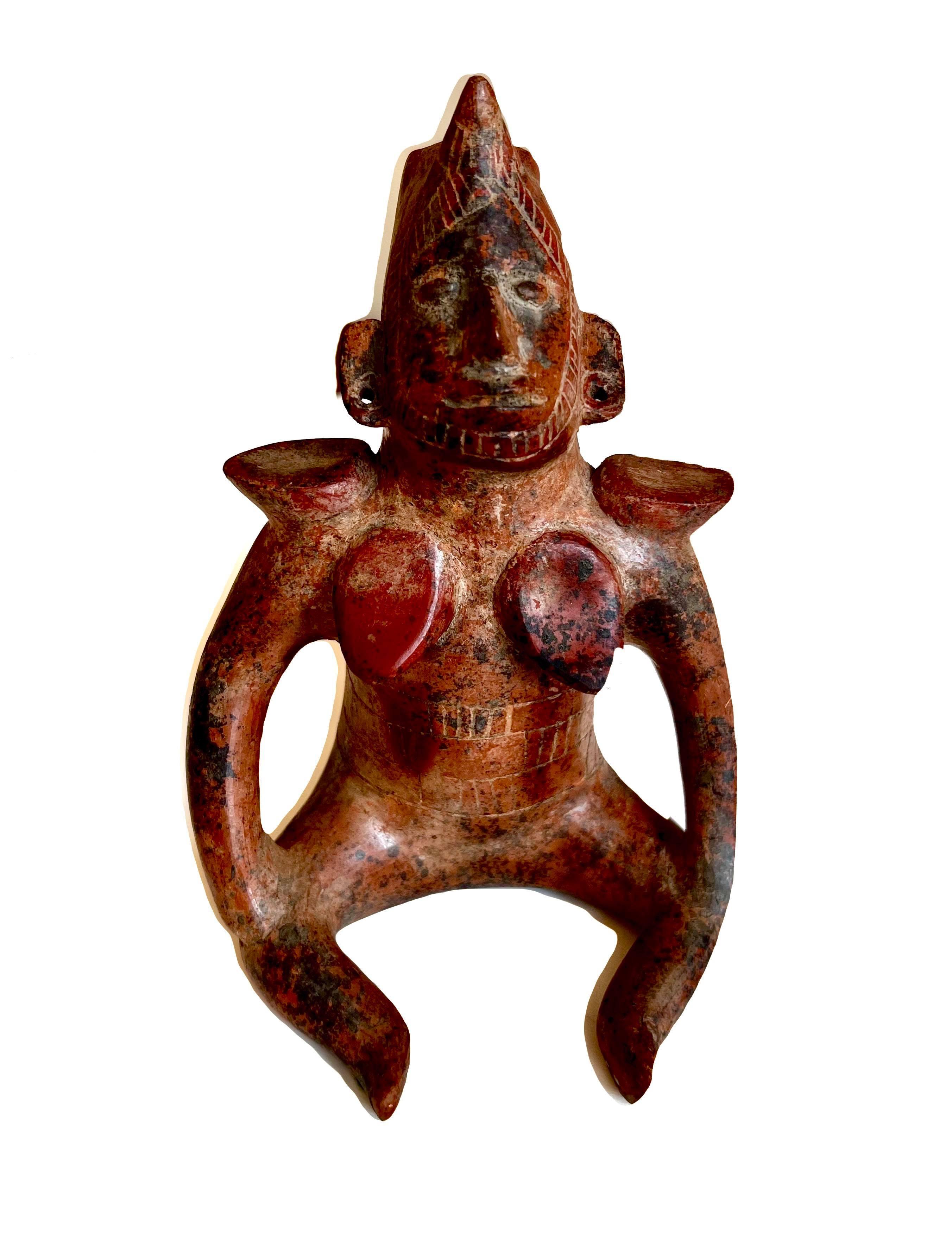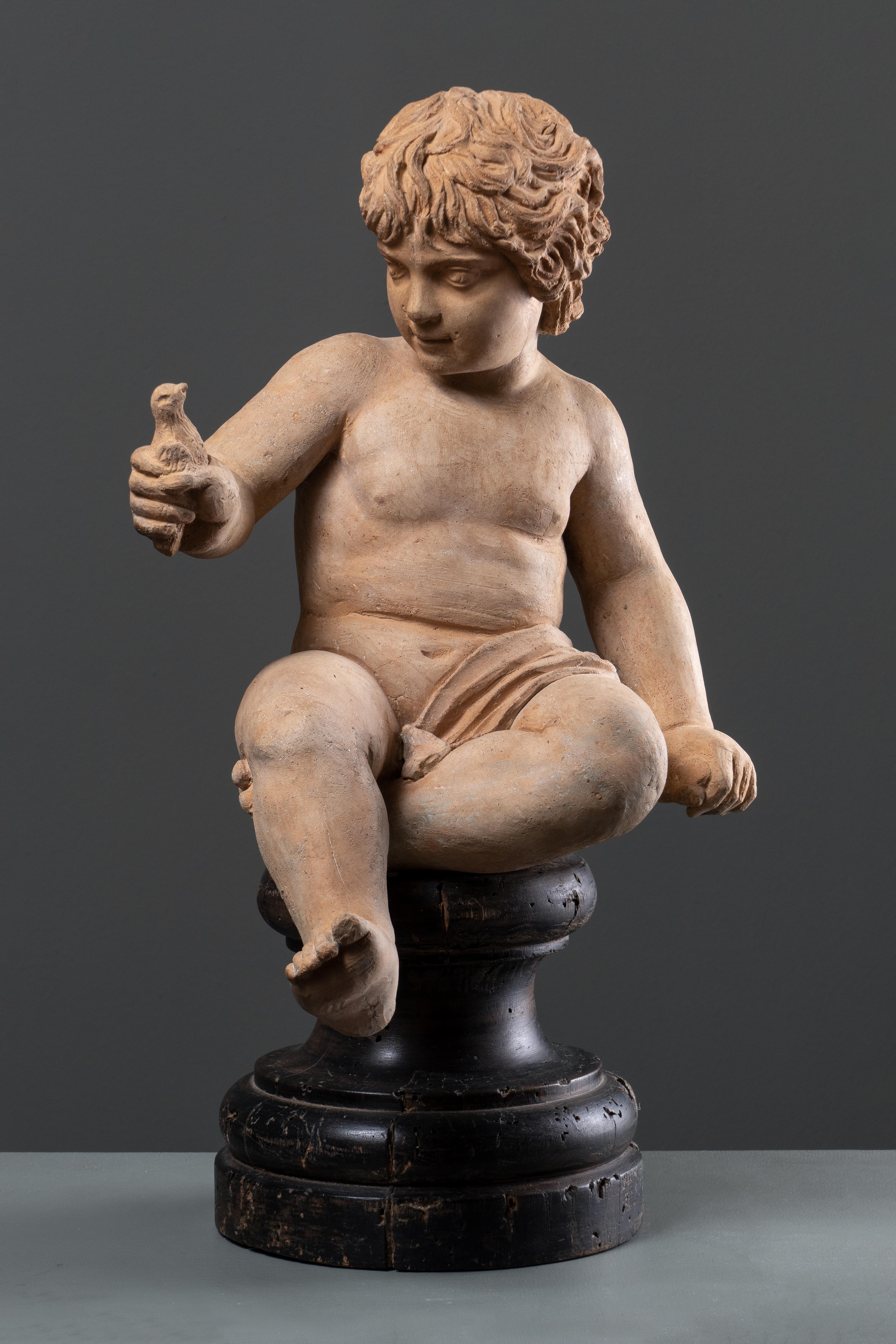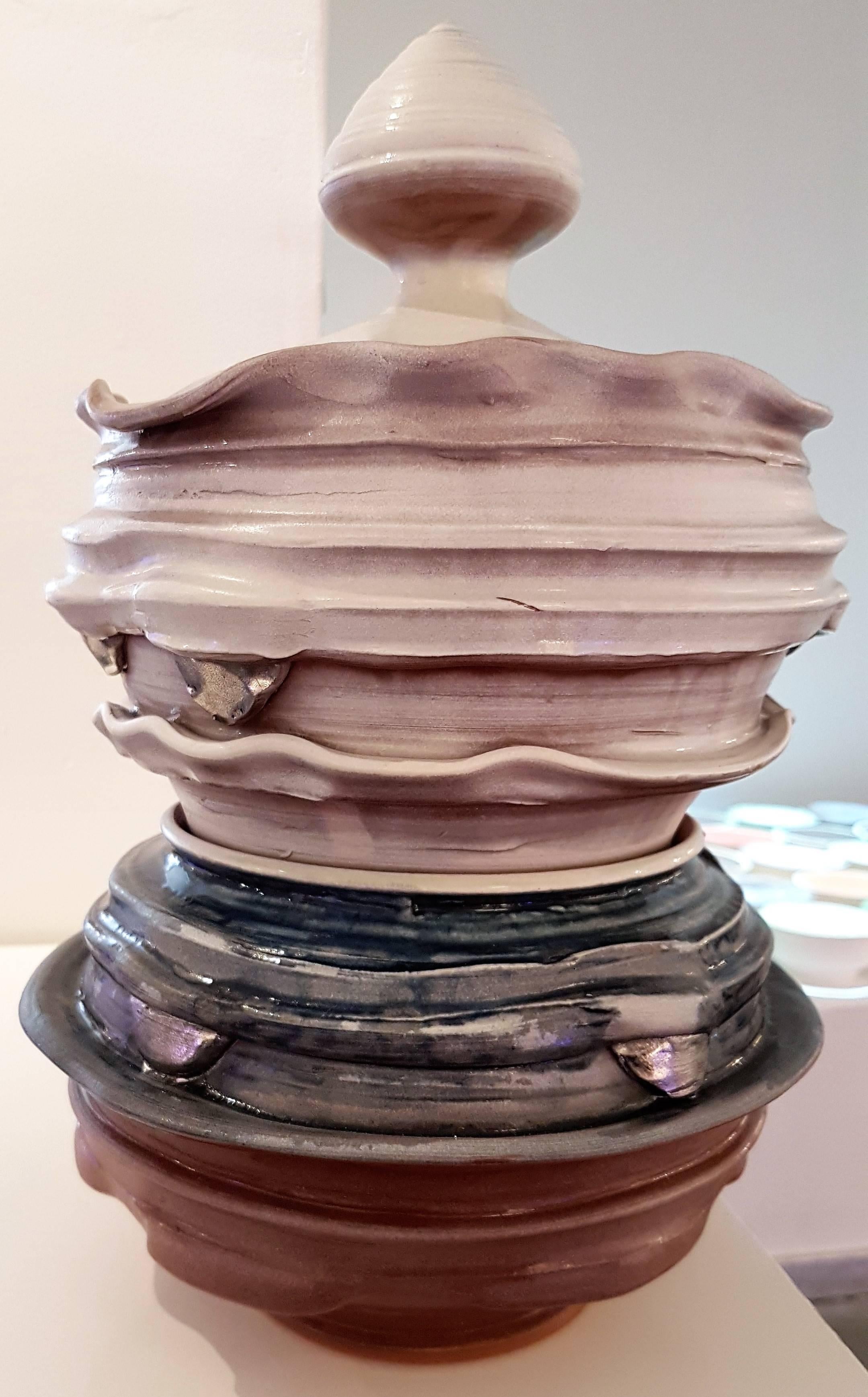Items Similar to Unknown Miniature Terracotta Head
Want more images or videos?
Request additional images or videos from the seller
1 of 7
UnknownUnknown Miniature Terracotta HeadUnknown
Unknown
About the Item
This small head of a ceramic figure with a bird headdress is probably Pre-Columbian. It seems to originate from the territory of present-day Mexico. Further research should reveal whether the fragment was made on Jaina Island. Can we situate it in the Late Classic Period, c. 600 – 850 AD? If the fragment indeed came from Jaina Island, it is most probably the head of a figurine that served as a burial gift. The clay figures, made by the artisans of Jaina, represented a broad spectrum of male and female professions, going from weavers, attendants, warriors, hunters, ballplayers, scribes, prisoners, dancers to musicians. Bird motifs were common in Mayan culture. They were often associated with the act of weaving, as they use twigs to build or weave their nests. They also could refer to hunting.
- Creation Year:Unknown
- Dimensions:Height: 4.34 in (11 cm)Width: 2.37 in (6 cm)Depth: 2.37 in (6 cm)
- Medium:
- Period:
- Condition:
- Gallery Location:brussel, BE
- Reference Number:
About the Seller
5.0
Vetted Seller
These experienced sellers undergo a comprehensive evaluation by our team of in-house experts.
1stDibs seller since 2021
13 sales on 1stDibs
Typical response time: 4 hours
- ShippingRetrieving quote...Ships From: leuven, Belgium
- Return PolicyA return for this item may be initiated within 3 days of delivery.
More From This SellerView All
- Scaled model of Chinese Ceramic workshop with 17 polychromed figures.End 19th CLocated in brussel, BEThe Diorama was in a private collection for more than 20 years and is said to have been exposed at the China Exposition 1902 in Copenhagen.This group of Chinese polychromed-decorate...Category
Late 19th Century Figurative Sculptures
MaterialsTerracotta
- 19th C Austrian Terracotta Buste attributed to Friedrich GoldscheiderLocated in brussel, BEFriedrich Goldscheider (1845 - 1897) was active/lived in Austria, France. Friedrich Goldscheider is known for Painting and sculpture. Friedrich Goldscheider was born in 1845 in Slabetz, Czech Republic and died 1897 in Nice. He is one of the most successful entrepreneurs in the history of European ceramics.Category
19th Century Figurative Sculptures
MaterialsTerracotta
- 17th C Stone statue of Saint Erasmus or Saint ElmoLocated in brussel, BESaint Erasmus or Saint Elmo (Antioch, ca. 240 – Formia, 303) was an Italian bishop and patron saint of the sailors. His attribute was the capstan, a winch on which the anchor chains were rolled up. He died as a martyr for his faith, and his bones were transferred to Gaeta in the 9th century, where they are kept in the cathedral to this day. The electric phenomenon of Saint Elmus fire is named after Saint Erasmus and the 16th C humanist Desiderius Erasmus. Little is known with certainty about Saint Erasmus' life. However, many legends may have been passed on orally until - no older writings are known with certainty. His birthplace was in present-day Syria. However, the persecution of Christians under Emperor Diocletian forced him to flee to Mount Lebanon...Category
17th Century Baroque Figurative Sculptures
MaterialsStone
- Bariba People, Benin, Rare Terracotta Ceremonial Altar Vessel.Located in brussel, BEThis pottery vessel, embellished with high relief figures, was made by women of the ethnic group of the Bariba (or Baatonu) in the northern provinces of Benin. The Bariba potters pas...Category
20th Century Figurative Sculptures
MaterialsStone
- Ancient Red Stone Village Millstone, Most probably from Ghana.Located in brussel, BEMillstones are used for grinding wheat and other grains. Initially, people used a rubbing stone to grind the wheat manually on a simple flat grinding stone. Later they grind the grai...Category
20th Century Tribal More Art
MaterialsStone
- Lucien Desmaré (Schaarbeek, 1905 - Brussels, 1961) Streetview with Two NunsLocated in brussel, BELucien Desmaré was a Belgian painter born in 1905 and who died in 1961. He was a painter, etcher, illustrator and decorator. He has followed training at the Academies in Anderlecht, ...Category
20th Century Figurative Prints
MaterialsLithograph
You May Also Like
- Buste de faune, Picasso, Ceramic, Terracotta, Faune, Mythological, Design, 1950'By Pablo PicassoLocated in Geneva, CHBuste de faune, Picasso, Ceramic, Terracotta, Faune, Mythological, Design Buste de faune Unique piece Partially glazed terracotta 18.5 x 9.3 cm 40 x 32 cm (with frame) Certificate o...Category
Mid-20th Century Post-War Abstract Sculptures
MaterialsTerracotta
- Visage à la grille, Picasso, Edition, 1950's, Face, Plate, White, Naif, CeramicBy Pablo PicassoLocated in Geneva, CHVisage à la grille, Picasso, Edition, 1950's, Face, Plate, White, Naif, Ceramic Visage à la grille Ed.100 pcs 1956 White earthenware clay, engobe decoration under partial brushed gl...Category
1950s Post-War Figurative Sculptures
MaterialsCeramic, Earthenware, Terracotta
- Clay Sculpture in Pre-Colombian Style ReproductionLocated in Troy, NYThis work is made out of ceramic terracotta and is in a Pre-Columbian style. It is a reproduction of sculptures typically found in the Colima culture in western Mexico. These origina...Category
1960s Folk Art Figurative Sculptures
MaterialsCeramic, Terracotta
- Antique Italian Terracotta Figure Of The Child Hercules, Rome, 18th CenturyLocated in Milan, ITAfter Alessandro Algardi (Bologna, 1585 - Roma,1654) YOUNG HERCULES, Italy, 18th Century terracotta 44 x 25 x 25 cm 17 1/4 x 9 3/4 x 9 3/4 in This lovely sculpture represents the young Hercules, seated with his legs crossed, gently holding a bird with his right hand, raised in the air, while supporting his own weight with his left hand. The artwork refers to the notorious Roman sculpture of the young Hercules killing the snakes sent by Hera, exhibited at the Capitoline Museums in Rome. Academics have identified the young emperor Caracalla or, more recently, Annio Vero, son of the emperor Marcus Aurelius, in the portrait of the sculpture. During the 16th Century there has been an increasing interest of patrons towards the theme of mythology and several acclaimed Italian sculptors worked on the creation of sculptures and depictions of Roman Gods. Among them, the distinguished baroque artist Alessandro Algardi worked on the restoration of several ancient sculptures...Category
18th Century Figurative Sculptures
MaterialsTerracotta
- Monumental Covered Jar #2By Mariko Brown HarkinLocated in Kansas City, MOTitle : Covered Jar Materials : Terracotta, white gold luster Date : 2016 Dimensions : 18.5 x 8.5 x 8.5 inches Description : wheel thrown and altered terracotta, cone 04 oxidation, glazes and luster COA provided Mariko Brown Harkin about her work: "My fascination with pottery comes from my desire to make art and to produce something that is not only functional but visually appealing. Porcelain allows me stretch and shape the clay in any way I choose and offers a blank canvas for my floral imagery and luscious, rich glazes to blend. The forms I create are tight and precise with a sense of restricted volume. I use bands around the form to constrict specific areas of each piece, while at the same time creating space for the volume and fullness to escape. The bands create registers to frame my drawings and paintings of floral imagery. The way I combine surface and form is inspired by Ming Dynasty porcelain...Category
2010s Contemporary Abstract Sculptures
MaterialsLuster, Terracotta, Glaze
- Monumental Covered Jar #1By Mariko Brown HarkinLocated in Kansas City, MOMaterials : Terracotta, white gold luster Date : 2016 Dimensions : 16 x 8.5 x 8.5 inches Description : wheel thrown and altered terracotta, cone 04 oxidation, glazes and luster COA provided Mariko Brown Harkin about her work: "My fascination with pottery comes from my desire to make art and to produce something that is not only functional but visually appealing. Porcelain allows me stretch and shape the clay in any way I choose and offers a blank canvas for my floral imagery and luscious, rich glazes to blend. The forms I create are tight and precise with a sense of restricted volume. I use bands around the form to constrict specific areas of each piece, while at the same time creating space for the volume and fullness to escape. The bands create registers to frame my drawings and paintings of floral imagery. The way I combine surface and form is inspired by Ming Dynasty porcelain...Category
2010s Contemporary Abstract Sculptures
MaterialsLuster, Terracotta, Glaze





